Design of an Ultra-Wideband MIMO Antenna with Open-Slot Structures for 5G Metal-Frame Smartphones †
Abstract
1. Introduction
2. Design and Analysis of Proposed Antenna
2.1. Configuration of Antenna
2.2. Antenna Evolution and Analysis
2.3. Parametric Study
2.4. MIMO Antenna Array
3. Measurement Results
3.1. MIMO Performance
3.2. Radiation Performance
3.3. Hand and Head Effects
3.4. Comparison
4. Conclusions
Author Contributions
Funding
Institutional Review Board Statement
Informed Consent Statement
Data Availability Statement
Acknowledgments
Conflicts of Interest
References
- Hong, W. Solving the 5G mobile antenna puzzle: Assessing future directions for the 5G mobile antenna paradigm shift. IEEE Microw. Mag. 2017, 18, 86–102. [Google Scholar] [CrossRef]
- Tran, G.K.; Dao, N.D.; Sakaguchi, K.; Araki, K.; Iwai, H.; Sakata, T.; Ogawa, K. Performance Analysis of MIMO Schemes in Residential Home Environment via Wideband MIMO Propagation Measurement. IEICE Trans. Fundam. Electron. Commun. Comput. Sci. 2010, E93-A, 814–829. [Google Scholar]
- Yu, H.; Shang, X.; Xue, Q.; Ding, H.; Wang, J.; Lv, W.; Luo, Y. Twelve-Element MIMO Wideband Antenna Array Operating at 3.3 GHz for 5G Smartphone Applications. Electronics 2024, 13, 3585. [Google Scholar] [CrossRef]
- Wong, K.-L.; Tsai, C.-Y.; Lu, J.-Y. Two Asymmetrically Mirrored Gap-Coupled Loop Antennas as a Compact Building Block for Eight-Antenna MIMO Array in the Future Smartphone. IEEE Trans. Antennas Propag. 2017, 65, 1765–1778. [Google Scholar] [CrossRef]
- Ding, C.F.; Zhang, X.Y.; Xue, C.-D.; Sim, C.-Y.-D. Novel Pattern-Diversity-Based Decoupling Method and Its Application to Multielement MIMO Antenna. IEEE Trans. Antennas Propag. 2018, 66, 4976–4985. [Google Scholar] [CrossRef]
- Jiang, W.; Liu, B.; Cui, Y.; Hu, W. High-Isolation Eight-Element MIMO Array for 5G Smartphone Applications. IEEE Access 2019, 7, 34104–34112. [Google Scholar] [CrossRef]
- Chen, Q.; Lin, H.; Wang, J.; Ge, L.; Li, Y.; Pei, T. Single Ring Slot-Based Antennas for Metal-Rimmed 4G/5G Smartphones. IEEE Trans. Antennas Propag. 2019, 67, 1476–1487. [Google Scholar] [CrossRef]
- Chang, L.; Yu, Y.; Wei, K.; Wang, H. Polarization-Orthogonal Co-Frequency Dual Antenna Pair Suitable for 5G MIMO Smartphone With Metallic Bezels. IEEE Trans. Antennas Propag. 2019, 67, 5212–5220. [Google Scholar] [CrossRef]
- Deng, C.; Liu, D.; Lv, X. Tightly Arranged Four-Element MIMO Antennas for 5G Mobile Terminals. IEEE Trans. Antennas Propag. 2019, 67, 6353–6361. [Google Scholar] [CrossRef]
- Ren, A.; Liu, Y.; Sim, C.-Y.-D. A Compact Building Block with Two Shared-Aperture Antennas for Eight-Antenna MIMO Array in Metal-Rimmed Smartphone. IEEE Trans. Antennas Propag. 2019, 67, 6430–6438. [Google Scholar] [CrossRef]
- Xu, H.; Gao, S.S.; Zhou, H.; Wang, H.; Cheng, Y. A Highly Integrated MIMO Antenna Unit: Differential/Common Mode Design. IEEE Trans. Antennas Propag. 2019, 67, 6724–6734. [Google Scholar] [CrossRef]
- Chang, L.; Yu, Y.; Wei, K.; Wang, H. Orthogonally Polarized Dual Antenna Pair with High Isolation and Balanced High Performance for 5G MIMO Smartphone. IEEE Trans. Antennas Propag. 2020, 68, 3487–3495. [Google Scholar] [CrossRef]
- Xu, Z.; Deng, C. High-Isolated MIMO Antenna Design Based on Pattern Diversity for 5G Mobile Terminals. IEEE Antennas Wirel. Propag. Lett. 2020, 19, 467–471. [Google Scholar] [CrossRef]
- Alja'AFreh, S.S.; Altarawneh, B.; Alshamaileh, M.H.; Almajali, E.R.; Hussain, R.; Sharawi, M.S.; Xing, L.; Xu, Q. Ten Antenna Array Using a Small Footprint Capacitive-Coupled-Shorted Loop Antenna for 3.5 GHz 5G Smartphone Applications. IEEE Access 2021, 9, 33796–33810. [Google Scholar] [CrossRef]
- Yang, B.; Xu, Y.; Tong, J.; Zhang, Y.; Feng, Y.; Hu, Y. Tri-Port Antenna with Shared Radiator and Self-Decoupling Characteristic for 5G Smartphone Application. IEEE Trans. Antennas Propag. 2022, 70, 4836–4841. [Google Scholar] [CrossRef]
- Ban, Y.-L.; Li, C.; Sim, C.-Y.-D.; Wu, G.; Wong, K.-L. 4G/5G Multiple Antennas for Future Multi-Mode Smartphone Applications. IEEE Access 2016, 4, 2981–2988. [Google Scholar] [CrossRef]
- Miao, Y.; He, L.; Liu, G. A Miniaturized Eight-Port MIMO Antenna for 5G Ultra-Slim Smartphones. Electronics 2025, 14, 566. [Google Scholar] [CrossRef]
- Xu, H.; Zhou, H.; Gao, S.; Wang, H.; Cheng, Y. Multimode Decoupling Technique with Independent Tuning Characteristic for Mobile Terminals. IEEE Trans. Antennas Propag. 2017, 65, 6739–6751. [Google Scholar] [CrossRef]
- Cui, L.; Guo, J.; Liu, Y.; Sim, C.-Y.-D. An 8-Element Dual-Band MIMO Antenna with Decoupling Stub for 5G Smartphone Applications. IEEE Antennas Wirel. Propag. Lett. 2019, 18, 2095–2099. [Google Scholar] [CrossRef]
- Jiang, W.; Cui, Y.; Liu, B.; Hu, W.; Xi, Y. A Dual-Band MIMO Antenna with Enhanced Isolation for 5G Smartphone Applications. IEEE Access 2019, 7, 112554–112563. [Google Scholar] [CrossRef]
- Ren, Z.; Zhao, A. Dual-Band MIMO Antenna with Compact Self-Decoupled Antenna Pairs for 5G Mobile Applications. IEEE Access 2019, 7, 82288–82296. [Google Scholar] [CrossRef]
- Guo, J.; Cui, L.; Li, C.; Sun, B. Side-Edge Frame Printed Eight-Port Dual-Band Antenna Array for 5G Smartphone Applications. IEEE Trans. Antennas Propag. 2018, 66, 7412–7417. [Google Scholar] [CrossRef]
- Li, J.; Zhang, X.; Wang, Z.; Chen, X.; Chen, J.; Li, Y.; Zhang, A. Dual-Band Eight-Antenna Array Design for MIMO Applications in 5G Mobile Terminals. IEEE Access 2019, 7, 71636–71644. [Google Scholar] [CrossRef]
- Hu, W.; Qian, L.; Gao, S.; Wen, L.-H.; Luo, Q.; Xu, H.; Liu, X.; Liu, Y.; Wang, W. Dual-Band Eight-Element MIMO Array Using Multi-Slot Decoupling Technique for 5G Terminals. IEEE Access 2019, 7, 153910–153920. [Google Scholar] [CrossRef]
- Zahid, M.N.; Gaofeng, Z.; Kiani, S.H.; Rafique, U.; Abbas, S.M.; Alibakhshikenari, M.; Dalarsson, M. H-Shaped Eight-Element Dual-Band MIMO Antenna for Sub-6 GHz 5G Smartphone Applications. IEEE Access 2022, 10, 85619–85629. [Google Scholar] [CrossRef]
- Hu, W.; Li, Q.; Wu, H.; Chen, Z.; Wen, L.; Jiang, W.; Gao, S. Dual-Band Antenna Pair with High Isolation Using Multiple Orthogonal Modes for 5G Smartphones. IEEE Trans. Antennas Propag. 2023, 71, 1949–1954. [Google Scholar] [CrossRef]
- Sun, L.; Li, Y.; Zhang, Z. Wideband Integrated Quad-Element MIMO Antennas Based on Complementary Antenna Pairs for 5G Smartphones. IEEE Trans. Antennas Propag. 2021, 69, 4466–4474. [Google Scholar] [CrossRef]
- Zhang, X.; Li, Y.; Wang, W.; Shen, W. Ultra-Wideband 8-Port MIMO Antenna Array for 5G Metal-Frame Smartphones. IEEE Access 2019, 7, 72273–72282. [Google Scholar] [CrossRef]
- Yuan, X.-T.; Chen, Z.; Gu, T.; Yuan, T. A Wideband PIFA-Pair-Based MIMO Antenna for 5G Smartphones. IEEE Antennas Wirel. Propag. Lett. 2021, 20, 371–375. [Google Scholar] [CrossRef]
- Sun, L.; Li, Y.; Zhang, Z.; Feng, Z. Wideband 5G MIMO Antenna with Integrated Orthogonal-Mode Dual-Antenna Pairs for Metal-Rimmed Smartphones. IEEE Trans. Antennas Propag. 2020, 68, 2494–2503. [Google Scholar] [CrossRef]
- Yuan, X.-T.; He, W.; Hong, K.-D.; Han, C.-Z.; Chen, Z.; Yuan, T. Ultra-Wideband MIMO Antenna System with High Element-Isolation for 5G Smartphone Application. IEEE Access 2020, 8, 56281–56289. [Google Scholar] [CrossRef]
- Chen, L. A Wideband Antenna Pair for 5G Smartphone Applications. In Proceedings of the 2024 IEEE 12th Asia-Pacific Conference on Antennas and Propagation (APCAP), Nanjing, China, 22–25 September 2024; pp. 1–2. [Google Scholar] [CrossRef]
- Hallbjorner, P. The Significance of Radiation Efficiencies When Using S-Parameters to Calculate the Received Signal Correlation from Two Antennas. IEEE Antennas Wirel. Propag. Lett. 2005, 4, 97–100. [Google Scholar] [CrossRef]
- Tang, T.C.; Lin, K.H. MIMO Antenna Design in Thin-Film Integrated Passive Devices. IEEE Trans. Compon. Packag. Manuf. Technol. 2014, 4, 648–655. [Google Scholar] [CrossRef]
- Gabriel, C. Tissue Equivalent Material for Hand Phantoms. Phys. Med. Biol. 2007, 52, 4205–4210. [Google Scholar] [CrossRef]
- Bazzi, A.; Bomfin, R.; Mezzavilla, M.; Rangan, S.; Rappaport, T.; Chafii, M. Upper mid-band spectrum for 6G: Vision, opportunity and challenges. arXiv 2025, arXiv:2502.17914. [Google Scholar] [CrossRef]

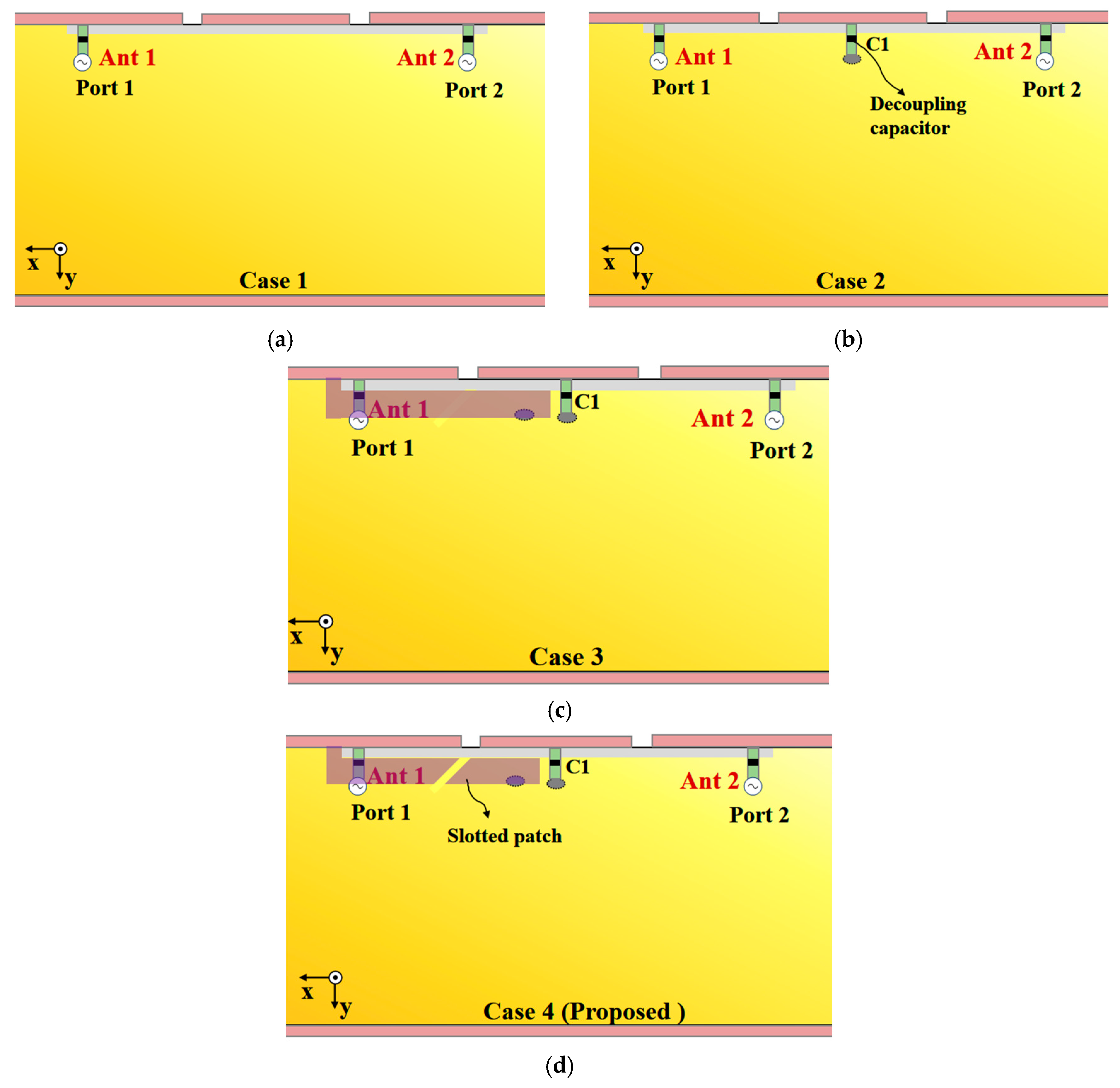

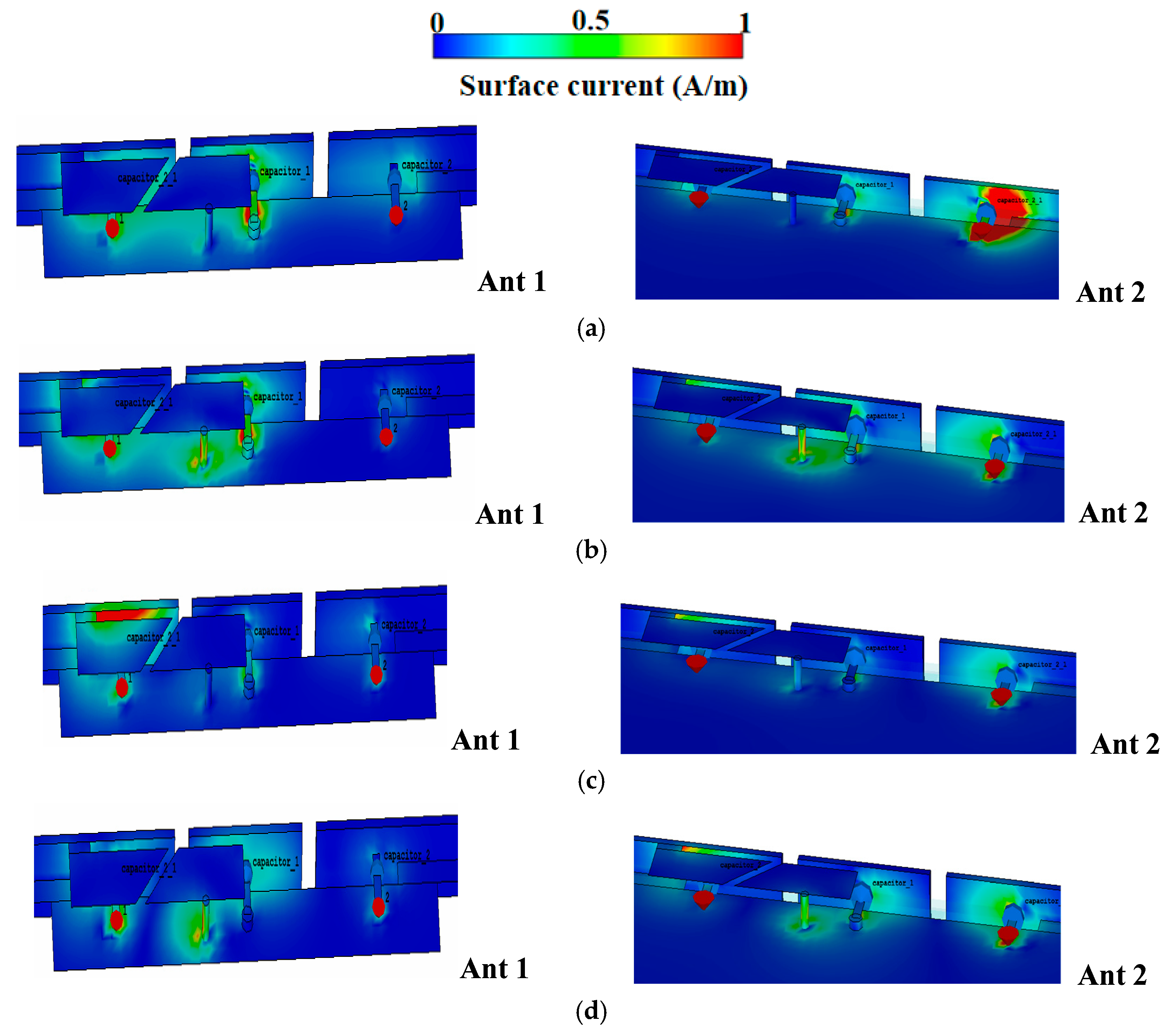
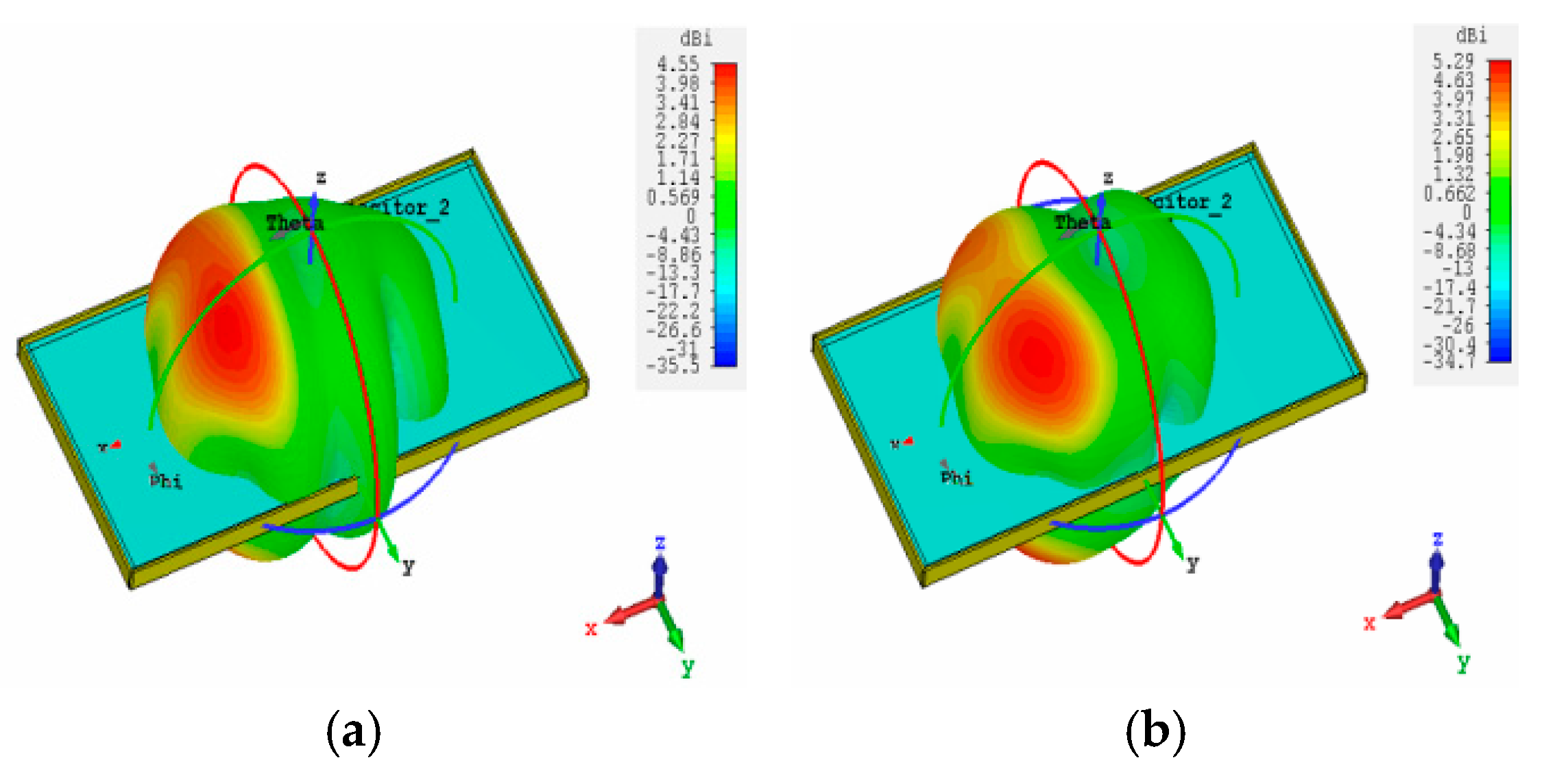
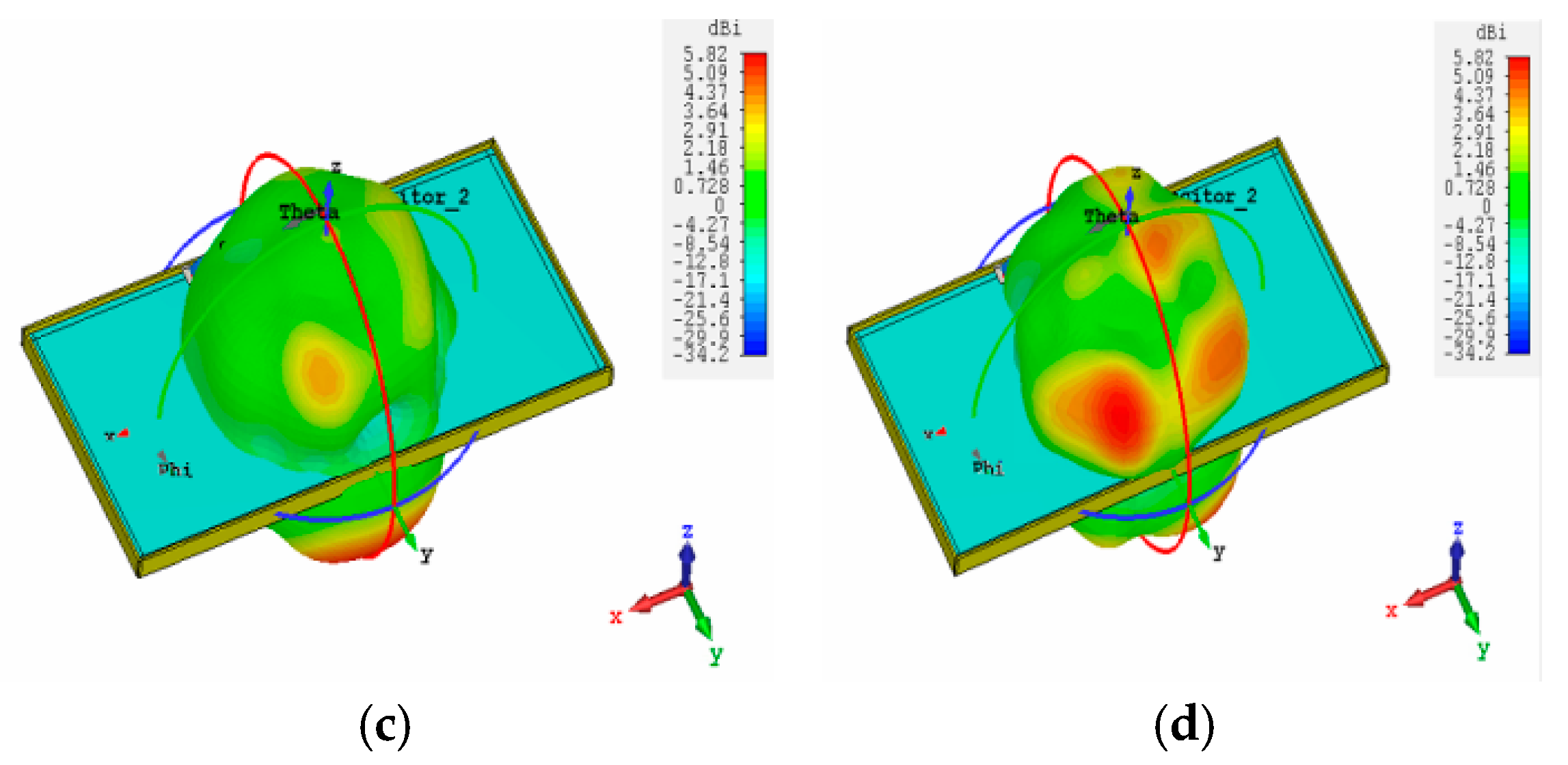
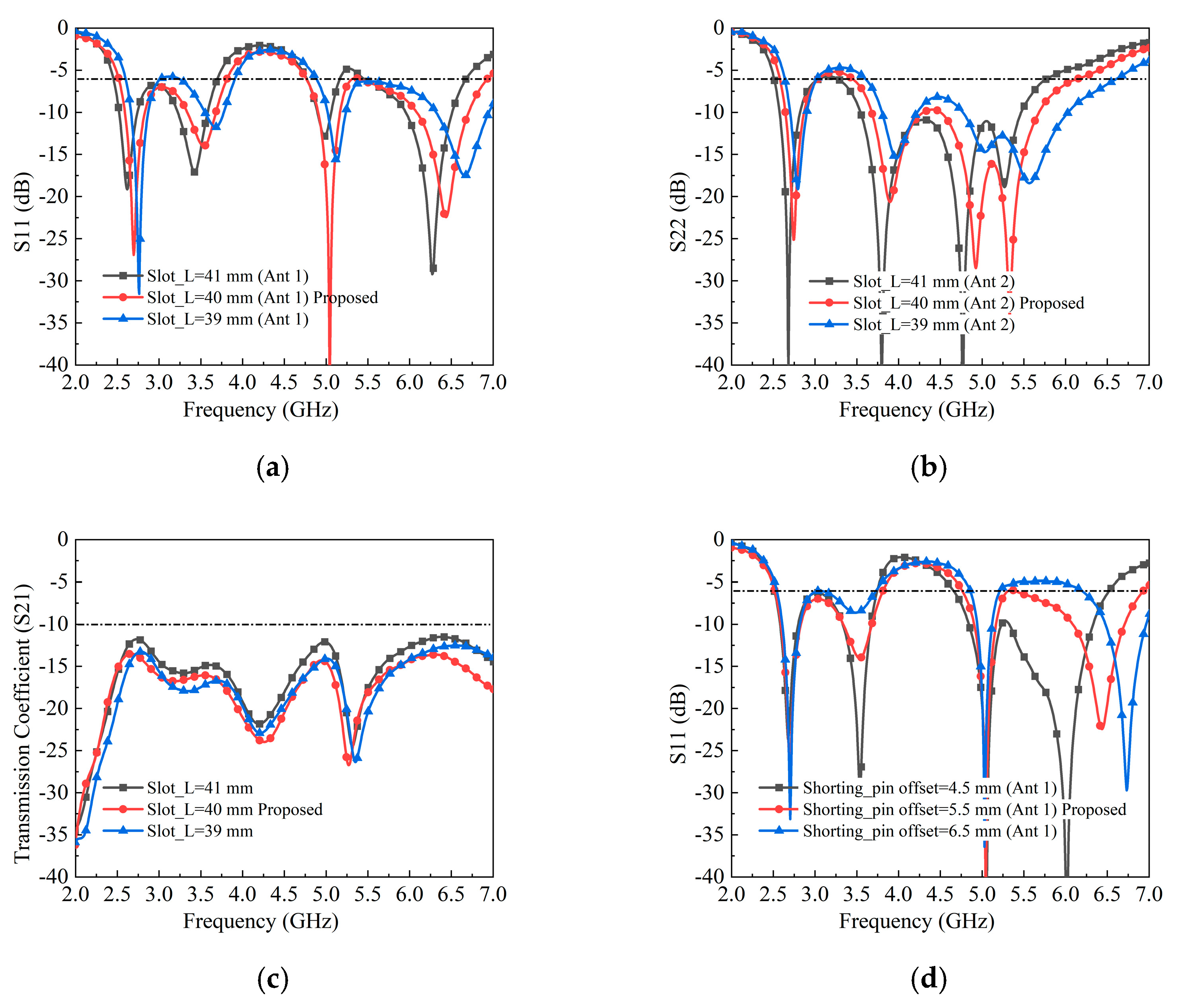
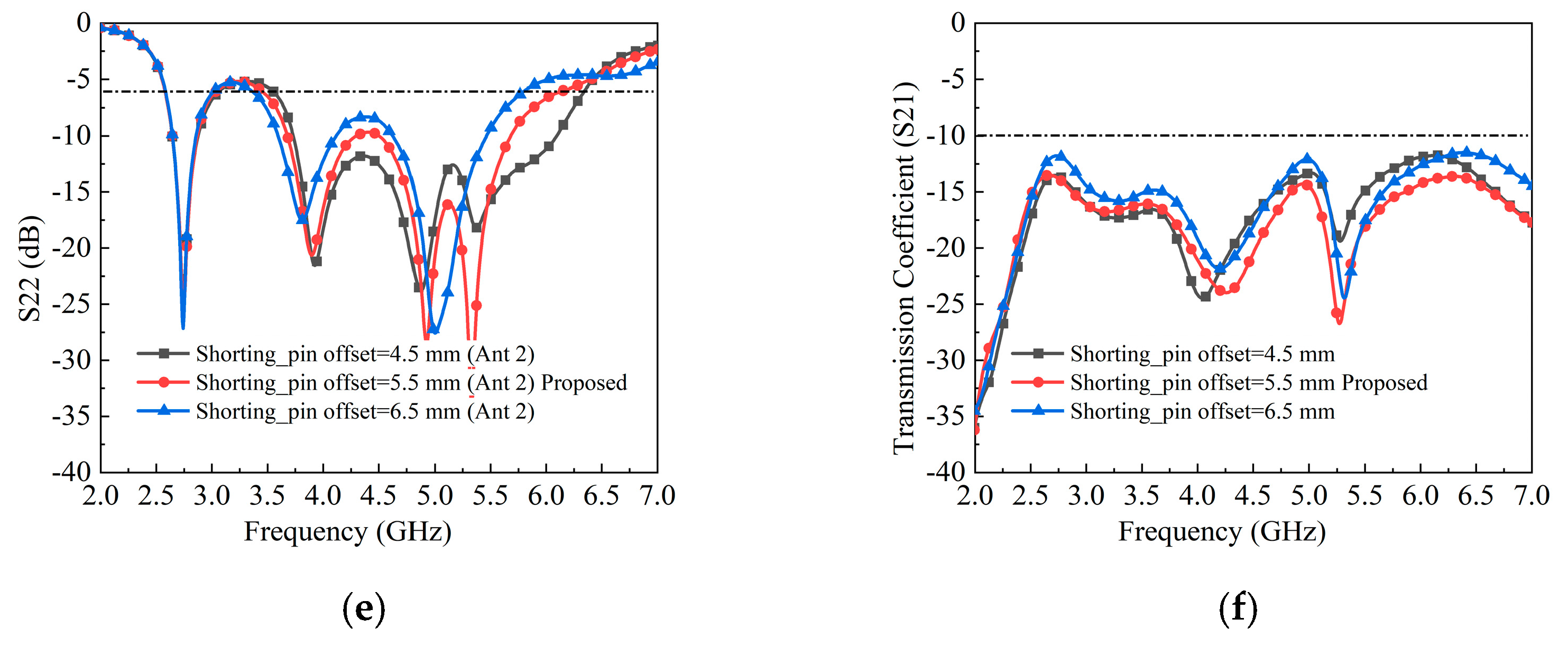
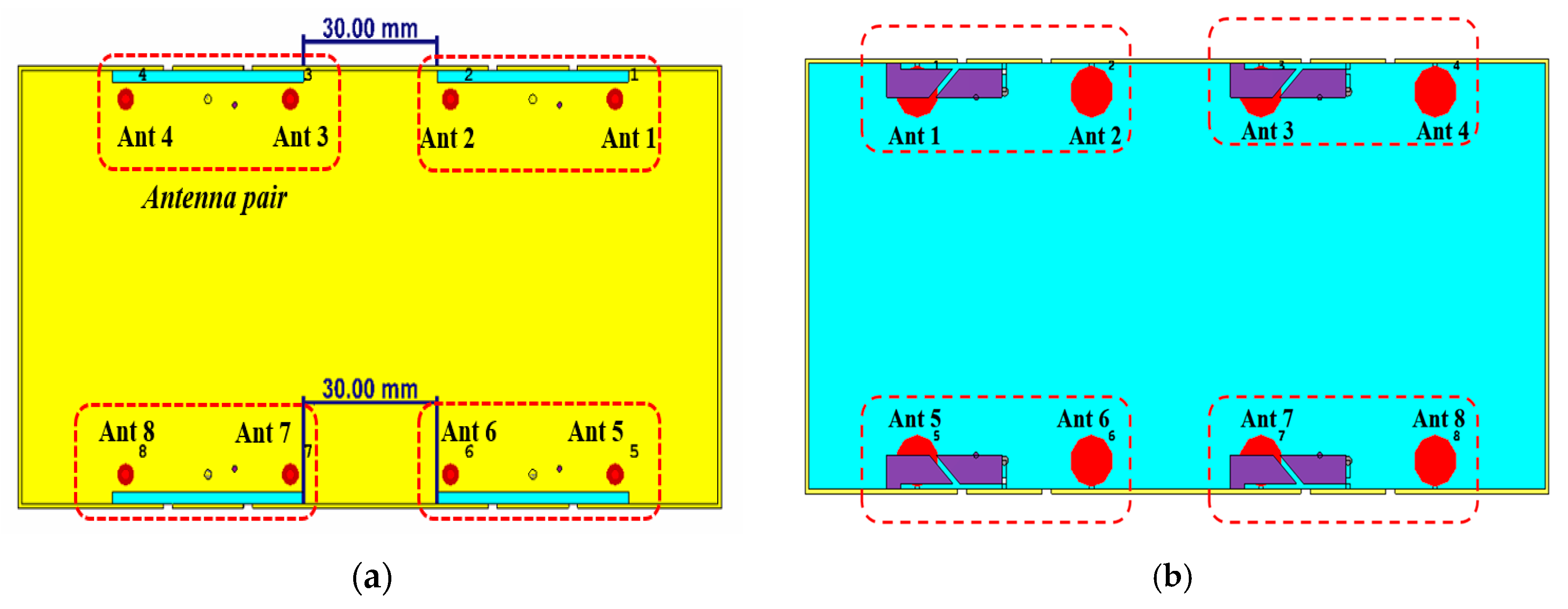
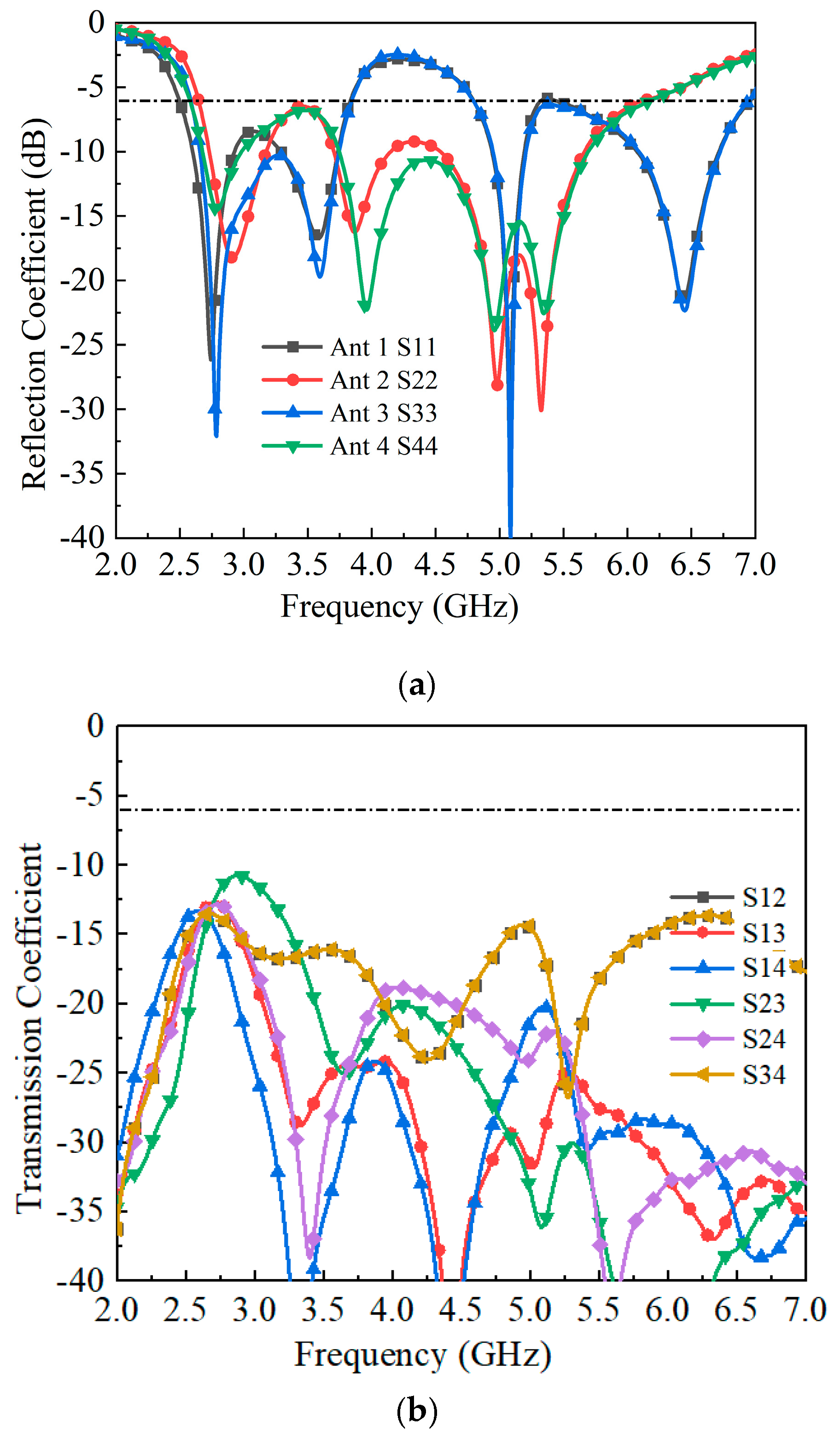
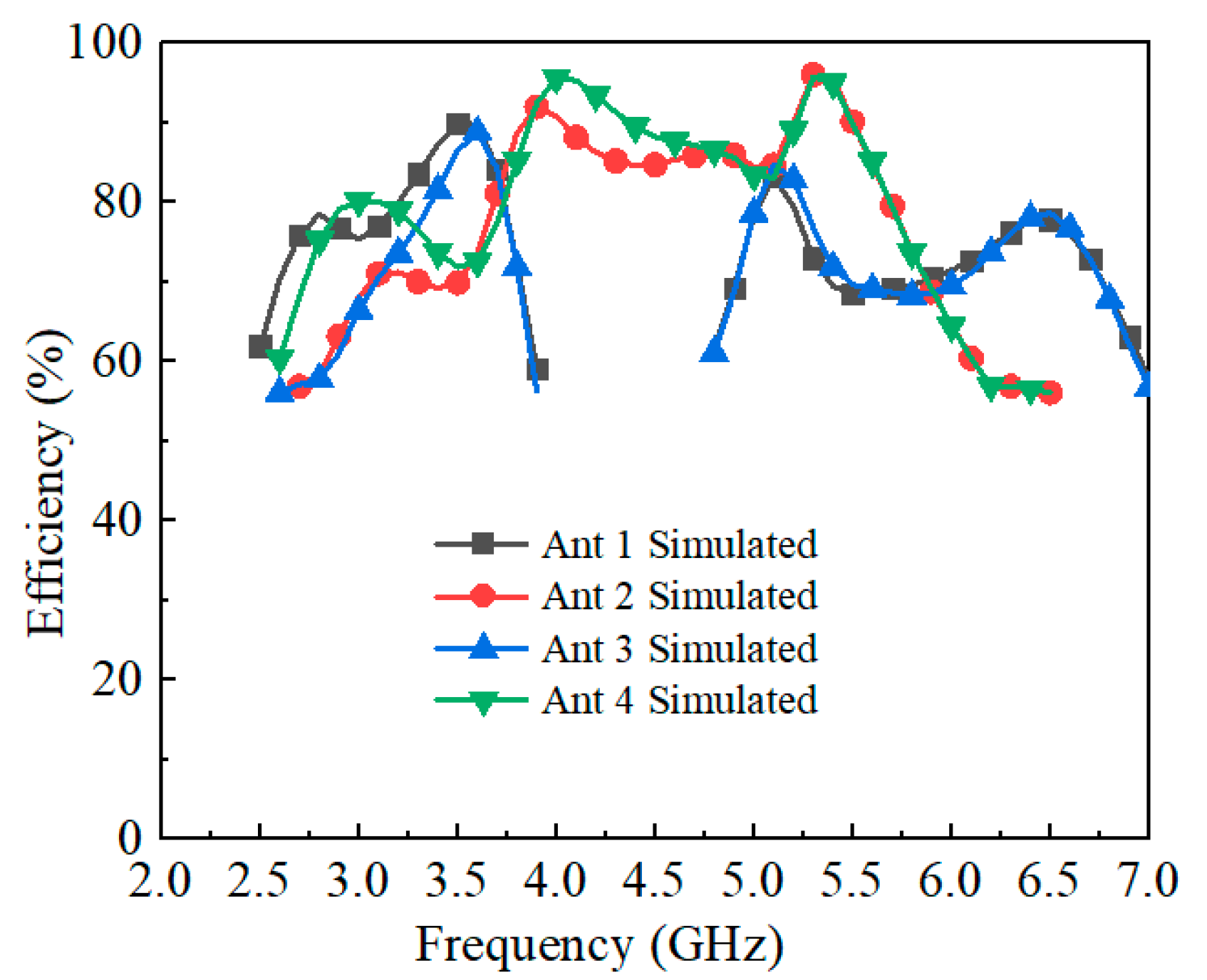
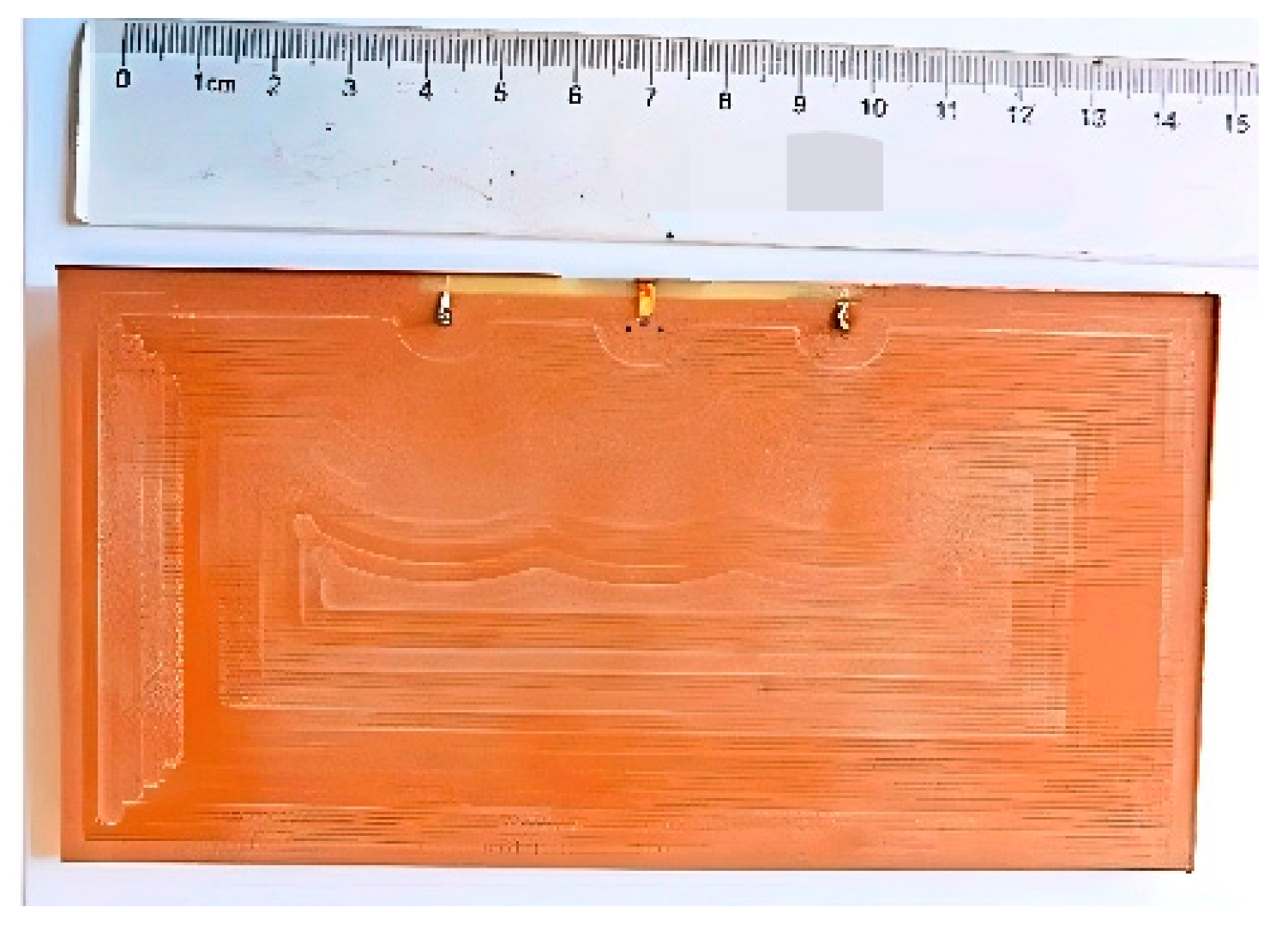
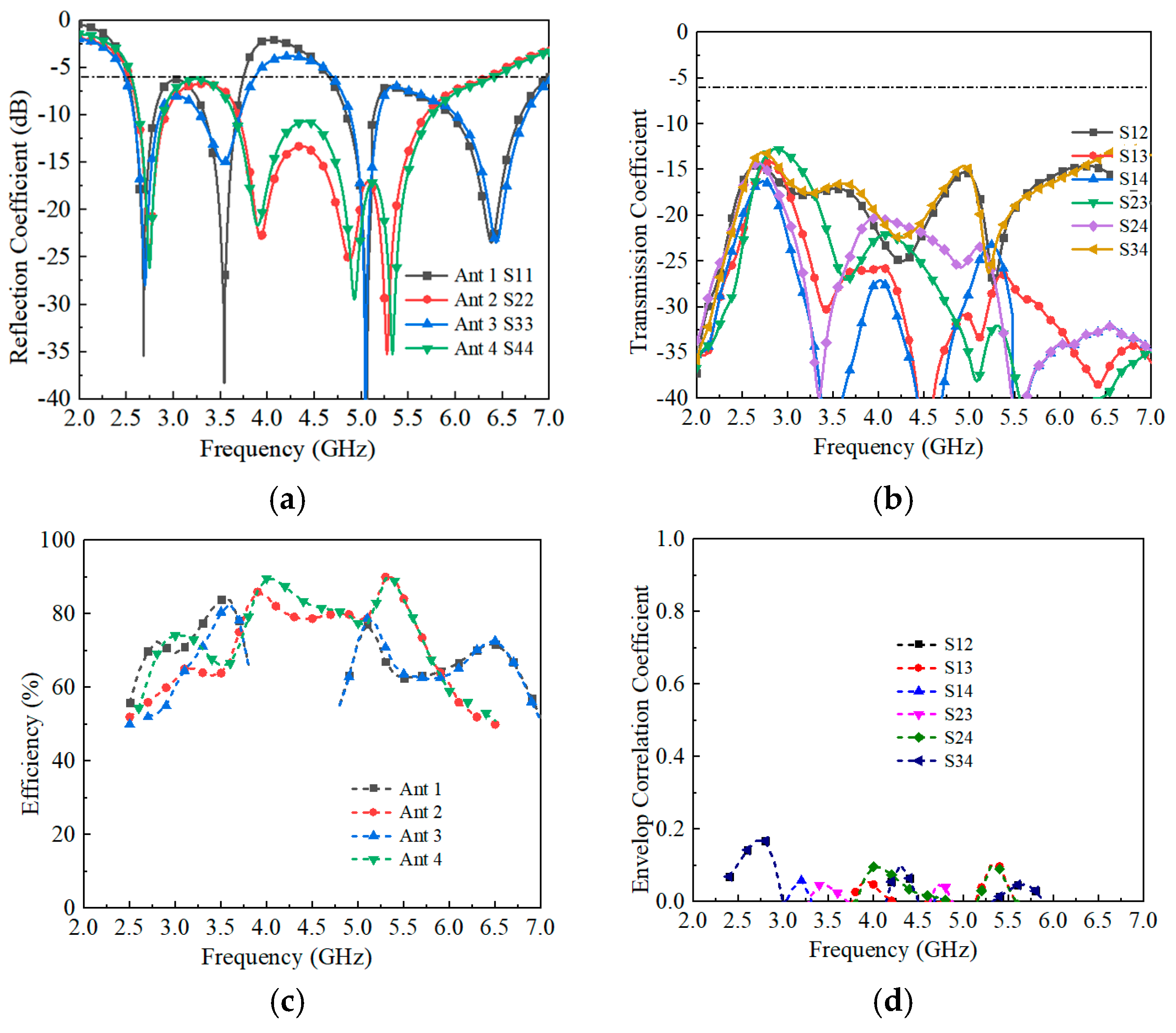


| Ref. | Metal Frame | Clearance (mm) | Total Bandwidth (GHz) | ECC | Isolation (dB) | Total Efficiency (%) |
|---|---|---|---|---|---|---|
| [15] | No | - | 0.2 (3.4–3.6) | <0.14 | >11.0 | >51 |
| [25] | No | - | 0.8 + 0.8 (3.1–3.9 & 5.5–6.3) | <0.03 | >12.0 | >70 |
| [26] | No | - | 0.3 + 0.6 (3.3–3.6 & 4.4–5.0) | <0.18 | >12.8 | >68 |
| [28] | Yes | 3 | 2.7 (3.3–6.0) | <0.1 | >11 | >40 |
| [29] | No | - | 4.2 (3.3–7.5) | <0.05 | >10 | >40 |
| [30] | Yes | 3 | 1.7 (3.3–5.0) | <0.11 | >12 | >31.6 |
| Prop. | Yes | 0.7 | Ant 1: 1.3 + 2.2 (2.5–3.8 & 4.8–7.0) | <0.18 | >12.6 | >56 |
| Ant 2: 4 (2.5–6.5) | <0.18 | >12.6 | >56 |
Disclaimer/Publisher’s Note: The statements, opinions and data contained in all publications are solely those of the individual author(s) and contributor(s) and not of MDPI and/or the editor(s). MDPI and/or the editor(s) disclaim responsibility for any injury to people or property resulting from any ideas, methods, instructions or products referred to in the content. |
© 2025 by the authors. Licensee MDPI, Basel, Switzerland. This article is an open access article distributed under the terms and conditions of the Creative Commons Attribution (CC BY) license (https://creativecommons.org/licenses/by/4.0/).
Share and Cite
Chen, L.; Bai, J.; Gu, H. Design of an Ultra-Wideband MIMO Antenna with Open-Slot Structures for 5G Metal-Frame Smartphones. Sensors 2025, 25, 5973. https://doi.org/10.3390/s25195973
Chen L, Bai J, Gu H. Design of an Ultra-Wideband MIMO Antenna with Open-Slot Structures for 5G Metal-Frame Smartphones. Sensors. 2025; 25(19):5973. https://doi.org/10.3390/s25195973
Chicago/Turabian StyleChen, Lvwei, Jingjing Bai, and Hongliang Gu. 2025. "Design of an Ultra-Wideband MIMO Antenna with Open-Slot Structures for 5G Metal-Frame Smartphones" Sensors 25, no. 19: 5973. https://doi.org/10.3390/s25195973
APA StyleChen, L., Bai, J., & Gu, H. (2025). Design of an Ultra-Wideband MIMO Antenna with Open-Slot Structures for 5G Metal-Frame Smartphones. Sensors, 25(19), 5973. https://doi.org/10.3390/s25195973






